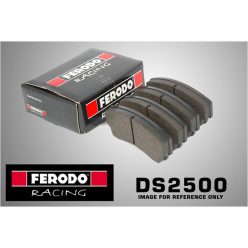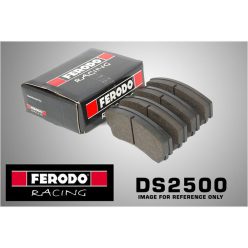Our Ferodo brake pads category focuses on high-performance and racing compounds for drivers who have outgrown standard OE friction. The well-known Ferodo compounds such as DS2000, DS2500, DS3000 and DS Performance cover everything from fast road and track day use to full competition. These pads are available for popular chassis like Lada, BMW E30/E36, Alfa Romeo and Mitsubishi, making it easy to choose a Ferodo setup that matches your car and your driving style.
Net price: 112 €
Net price: 106 €
Net price: 94 €
Net price: 89 €
Net price: 114 €
Net price: 123 €
Net price: 164 €
Net price: 143 €
Net price: 102 €
Net price: 159 €
Net price: 123 €
Net price: 149 €
Net price: 129 €
Net price: 112 €
Ferodo brake pads for fast road and motorsport use
The Ferodo brake pads range on LLRacing is designed for enthusiasts and racers who need more consistent stopping power than standard road pads can deliver. Ferodo offers several compounds – DS2000, DS2500, DS3000 and DS Performance – each tuned for a specific operating window and driving scenario. From track day and club-level racing to powerful road cars used in spirited driving, these pads provide firm pedal feel and predictable friction. It is important to note that some compounds are intended for circuit use only, so their legality on public roads depends on local regulations.
Decades of competition experience have been transferred into the Ferodo DS range, which is why these pads are widely used in touring car, rally and hill-climb series. DS Performance targets high-performance road cars, combining a race-inspired bite with refinement suitable for daily driving. In contrast, DS2500 and DS3000 are clearly more track-focused, prioritising high temperature stability and consistent coefficient of friction over noise or dust. When matched correctly to the car and driver, a Ferodo pad set will deliver repeatable braking performance, allowing you to concentrate more on braking points and race lines.
Technical Basics
The DS2000, DS2500, DS3000 and DS Performance compounds are engineered with different friction materials to suit road, track day and full race use. DS Performance is aimed at road-legal high-performance cars, with good cold bite, fast warm-up and compatibility with OE-style discs. The more competition-oriented DS compounds, such as DS2500 and DS3000, are formulated for sustained high temperatures, where the pad must maintain friction under repeated heavy braking. A key point is that dedicated racing materials may not carry ECE R90 approval, so they are not officially homologated for road use in many markets.
From a technical perspective, the most important parameters are the pad’s coefficient of friction, its stability across the working temperature range and its disc-friendliness. DS2500 is typically recommended for track day and light competition, offering good modulation and reasonable disc wear. DS3000 steps further toward a pure race compound, with higher friction and a shorter bedding time, making it suitable for sprint racing, rally or hill-climb where maximum braking is required. DS Performance stays closer to an uprated OE pad, but still resists fade significantly better than standard materials when used on powerful road or tuned cars. Always remember: different compounds react differently to heat, so pad choice should be matched to disc type, brake fluid and tyre grip.
Selection Criteria
Selecting the right Ferodo brake pad starts with defining how the car is actually used: daily driving only, fast road, regular track days or full race. For primarily road-driven performance cars, DS Performance is usually the most sensible option thanks to its road approval, cold response and acceptable noise level. For mixed fast road and frequent track days, DS2500 has become a popular choice, combining stronger bite and higher temperature capability with good modulation. Serious competitors often move to DS3000, which provides very strong braking at race temperatures, at the expense of higher dust, noise and potential rotor wear. Important: if the car is driven to the track on public roads, pad legality and safety in cold conditions must be considered alongside outright performance.
Other key factors are vehicle weight, power level, brake disc size and tyre grip. A heavier or more powerful car – or one running slick or semi-slick tyres – will generate more heat in the brakes, which pushes the choice toward higher-temperature compounds such as DS3000. For lighter cars or those mainly used in club-level events, DS2000 or DS2500 may offer a more usable balance between bite, modulation and operating cost. It is also worth considering the type of events: repeated high-speed braking on a circuit stresses the brakes differently than short, intense stages in rally or hill-climb. The general rule is to avoid using an under-specified compound that fades, but also to avoid over-specifying the pad so much that it performs poorly when cold.
Installation & Maintenance
When installing Ferodo brake pads, it is essential to check the condition and thickness of the discs, especially when using higher-friction DS compounds. Grooved, cracked or significantly worn discs should be replaced before fitting new pads, as race-derived materials will load the rotor more heavily. All contact surfaces and sliding points in the caliper must be cleaned, and high-temperature brake grease applied only to the appropriate areas – never on the pad friction face. Correct bedding-in is critical: a series of progressively harder stops, with cooling periods in between, helps transfer an even layer of material onto the disc. Warning: hard, repeated stops from high speed on brand new pads can glaze the surface and reduce performance.
From a maintenance perspective, pad thickness, disc condition and brake fluid quality should be monitored regularly, particularly after track days or races. Visual inspection of DS pads can reveal cracks, delamination or discolouration, all of which may indicate excessive heat. Motorsport use also increases the risk of boiling the brake fluid, which causes a soft or “spongy” pedal, so a high-boiling-point racing fluid is strongly recommended. Hardware items such as caliper pins, springs and sliders should be checked and re-torqued to the manufacturer’s specification to ensure reliable operation. After any major change to pads or discs, it is wise to carry out a controlled test drive to verify pedal feel and performance before driving flat-out.
FAQ
Which Ferodo compound is best for fast road use?
For fast road and occasional spirited driving, DS Performance is usually the best match because it is designed for high-performance road cars and is generally ECE R90 compliant. It offers good cold bite, stable friction under repeated hard stops and a refinement level acceptable for daily use. In most cases, it is a clear step up from standard OE pads without the downsides of a full race compound.
When should I upgrade to Ferodo DS2500 pads?
You should consider DS2500 if you attend track days regularly or drive very aggressively on twisty roads where brake temperatures rise significantly. DS2500 provides stronger bite and better fade resistance than road-focused pads while still remaining relatively easy to modulate. However, it can be noisier and dustier than DS Performance, and may not be approved for road use in all countries, so always check local regulations.
What is the main difference between DS2500 and DS3000?
The primary difference is that DS3000 is a more extreme race compound with higher friction and a working range aimed firmly at competition use. It is commonly used in touring car, rally and hill-climb applications where the brakes are exposed to very high continuous temperatures. DS2500, by comparison, is more forgiving, better suited to mixed track day and club-level use, and tends to be slightly kinder to discs. DS3000 is generally not recommended for normal road driving.
Can I run Ferodo racing pads on standard brake discs?
Many DS pad shapes are designed to fit OE-size discs, so they will physically install on standard calipers and rotors. However, the increased friction and heat can accelerate disc wear or lead to cracking if the rotors are of basic road quality and see repeated heavy track use. For serious circuit or rally work, combining DS pads with motorsport-grade discs and high-temperature brake fluid is strongly advised. For occasional track days, good-condition OE discs can be acceptable if inspected frequently.
Why is bedding-in Ferodo pads so important?
Proper bedding ensures that pad and disc surfaces mate correctly and that a stable transfer layer is formed on the rotor. This improves initial bite, reduces the risk of judder and helps prevent uneven deposits that can cause vibration or noise. Skipping or rushing the bedding process is one of the most common reasons for disappointing brake performance after an upgrade. A structured bedding procedure is especially critical with DS2500 and DS3000 compounds used in motorsport conditions.













